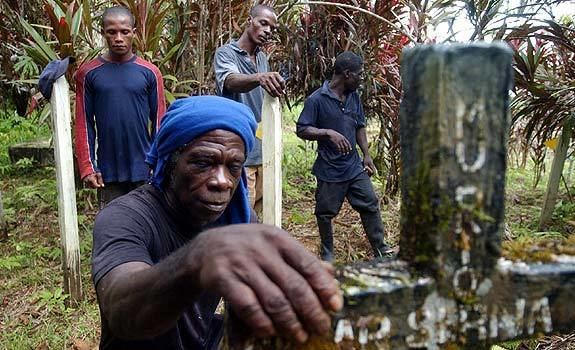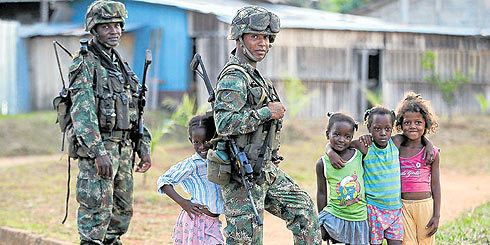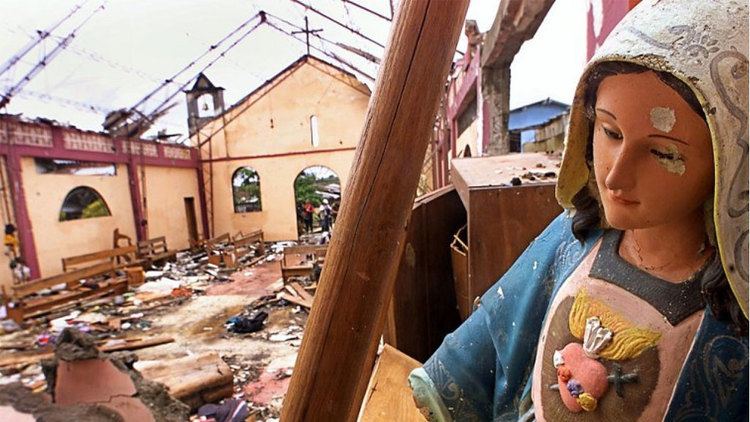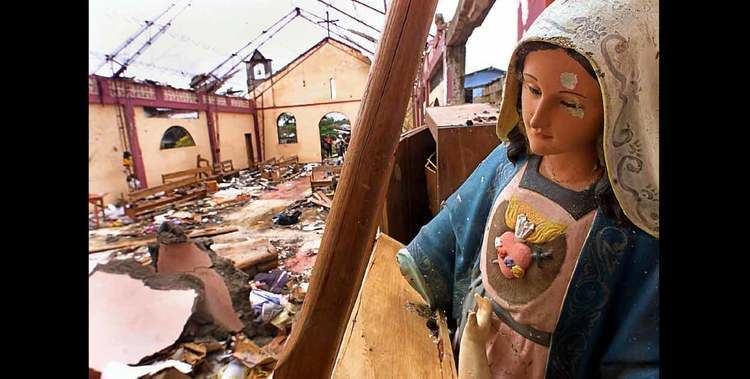Perpetrators FARC Total number of deaths 119 | Non-fatal injuries 98 Date 2 May 2002 Perpetrator FARC | |
 | ||
Target Civilians caught in the cross fire between the AUC paramilitaries and FARC guerrillas Weapons Handgun, Improvised explosive device Similar Colombian conflict, La Violencia, Palace of Justice siege, Operation Jaque, Dos de Mayo Uprising | ||
Bojay massacre
The Bojayá massacre (Spanish: La Masacre de Bojayá) was a massacre that occurred on May 2, 2002 in the Colombian town of Bojayá (with its urban centre also referred to as Bellavista), in Chocó department. FARC guerrillas seized the town in an attempt to take control of the Atrato River region from AUC paramilitaries, in the process killing approximately 119 civilians in an apparently indiscriminate attack with an improvised homemade mortar assembled with gas cylinders parts (known in Spanish as pipeta or Cilindro bomba).
Contents
- Bojay massacre
- Background
- Preceding events
- Details of the attack
- Responsibility of the state
- Death of perpetrator
- References

Background

As previously noted by the Colombian government, "the armed confrontation in the region between the guerrillas and the illegal self-defence forces is very violent due to the economic and strategic interests in play, including, among others: drug trafficking, the inter-oceanic connection, the development of megaprojects like the Panamerican Highway, and the proximity of ports and hydroelectric stations. The region furthermore represents advantages for these groups as a route for the import of arms and supplies from Central America and to provide favourable routes for drug trafficking."
Preceding events

At least 250 paramilitary combatants moved into Bellavista on 21 April 2002, and remained in the populated area despite protests by local residents. The UNHCHR sent an official communication to the Colombian government on April 23 expressing their concern regarding the presence of the paramilitaries and the possible consequences for the local people. The Ombudsman's Office of Colombia also visited the region on April 26 and released an early warning regarding the possible consequences of an armed confrontation in the area.

Intense fighting broke out on May 1 in neighboring Vigía del Fuerte municipality (Antioquia department), and spread to Bellavista later in the day. Residents took shelter in the local church, the adjoining parsonage and an Augustinian Missionary residence, with the total number approaching 500 over the course of the night.
Details of the attack

According to the official UN investigation report, in the morning of May 2 the AUC paramilitaries had established positions around the church, using the buildings and the cement wall around the church yard for protection. The FARC took up positions to the north (in Barrio Pueblo Nuevo), and began launching gas cylinder bombs (pipetas) toward the paramilitary positions, with two landing nearby but the third going through the roof of the church and exploding on the altar.
The explosion caused approximately 119 dead and 98 wounded, though the UN was not able to verify exact numbers. A large number of the dead and wounded were children.
The UN investigation found the FARC in violation of several principles of international humanitarian law, including an indiscriminate attack causing unnecessary civilian casualties, failure to distinguish between civilian and combatant, failure to take efforts to protect civilians from avoidable harm, and attacks against cultural property. Prohibitions against these acts are found in Common Article 3 of the 1949 Geneva Conventions and Articles 4, 13, and 16 of Additional Protocol II. The UN also considered the FARC responsible for the forced displacement generated as a consequence of the attack on the church, placing the act in violation of Article 17 of Protocol II.
The UN also found the AUC in violation of various aspects of international humanitarian law, including using civilians as human shields, failing to protect civilians from the effects of their military operations, and for causing massive forced displacement of civilian populations in the region due to their acts, threats and combat operations in the area. Given reports of theft by the AUC of goods, equipment and vehicles belonging to local residents, the UN also found the AUC guilty of pillage (a violation of Article 17 of Protocol II).
The UNHCHR also found that the Colombian government failed to act in order to prevent the massive human suffering resulting from the events in Bojaya - suffering that was predicted and of which the government was explicitly warned beforehand.
Responsibility of the state
The First Administrative Court of Quibdo, Chocó sentenced the Colombian State to a billion and a half Colombian peso compensation to relatives of two of the dead victims on May 29, 2008. It ruled the State was administratively responsible and had neglected to protect its citizens, despite the warnings of the ombudsman.
Death of perpetrator
At dawn of 22 February 2012, nearly 10 years after the event, a Colombian Air Force EMB-314 aircraft identified the camp of FARC's 57th Front, 15 kilometers north of Bojayá near the border with Panama. The Super Tucano dropped two high-precision bombs destroying the camp and killing six FARC rebels including Pedro Alfonso Alvarado alias "Mapanao", responsible for the massacre.
